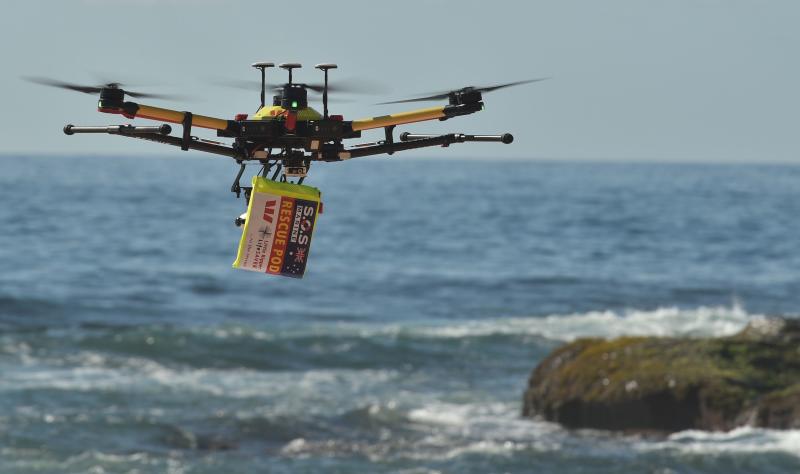Rise of the drone poses regulation headache for Australia
Sign up now: Get ST's newsletters delivered to your inbox

A shark-spotting drone flying over Bilgola Beach in northern Sydney on Dec 10, 2017.
PHOTO: AFP
Follow topic:
SYDNEY - Australians' enthusiasm for drones is growing, with the devices being used by everyone from farmers to beach lifeguards and commercial photographers.
But the proliferation of the devices has raised concerns about their safety, prompting warnings that the nation's new-found obsession could end in catastrophe.
The Civil Aviation Safety Authority estimates there are more than 100,000 privately-operated drones in Australia - "most of which are used for sport and recreational purposes," a spokeswoman told The Straits Times.
But the precise number is unknown because non-commercial devices typically do not need to be registered.
Current rules, which were tightened last October, require private and recreational users to keep drones within line-of-sight and away from airports and aircraft.
The devices must be flown during daytime only, kept 30 metres away from other people and cannot fly 120 metres above the ground or places where people are gathered, such as beaches, parks and sports fields. Some states require them to be kept away from wildlife such as whales and dolphins.
But there are concerns about whether drone operators are familiar with the rules. There have been near-misses with aircraft as well as incidents in which drones have crashed into apartment windows and landed on cars.
Some councils have banned the use of drones over public land and there are growing calls to require users to pass a test.
Late last year, Casey Council in Melbourne banned people from using drones outside their own properties unless they had a licence. The penalty for breaking the rule is AU$300 (S$315).
"The council has already collected and destroyed two drones that crash-landed, but has not issued any fines," the council's safer communities manager, Ms Caroline Bell, told The Herald Sun last month.
The CASA has been penalising users for dangerous flying. It has issued 43 fines to people for breaching one or more rule, each of which can involve a fine of up to $AUS1,050. More serious infringements, or reckless operation which endangers a person, can lead to fines of up to $AUS10,050 or imprisonment.
"We look into all reports and where there is sufficient evidence of a safety breach, such as photos or video recordings of the breach and the person controlling the drone, further enforcement action may be taken," the CASA's spokeswoman said.
A Parliamentary inquiry has been examining drone safety rules. It was told there were 180 near misses between the devices and other aircraft in 2016.
MP and former air crash investigator Mr Barry O'Sullivan is deputy chairman of the inquiry. He said last year that he believed the current drone regulations were a "catastrophe waiting to happen". He suggested licences may be necessary, likening the current rules to allowing children or unlicensed people to drive cars.
"We must get out in front of this so we can restore, as best we can, air safety," he told The Australian Financial Review.
The inquiry's final report is due to be released in late March and is expected to call for tougher laws.
In anticipation, the drone industry has insisted the current regime is adequate and that more rules would limit the growing use of the devices.
Chinese drone manufacturing giant DJI said the current rules are "sensible".
"Australia has a real opportunity to be an innovator in this field," Mr Adam Welsh, from DJI, told Sydney's Daily Telegraph on Wednesday.
"There's a lot of great use cases for drones in Australia, like using drones to survey things like power lines and utilities."
Indeed, the devices are proving useful in Australia.
At the nation's beaches this summer, lifeguards have begun using drones to spot sharks and even to perform beach rescues.
Elsewhere, they are being used to identify areas where there is a risk of landslides along coastal roads.
On January 18, a drone was used by lifeguards to rescue two teenagers who were dragged out to sea while swimming. The drone, which was being trialled, was used to spot the boys then drop a flotation device which allowed them to return to shore.
Nonetheless, on Wednesday it emerged that a drone which was part of the same trial had to be crashed into the sea after it suffered a mechanical problem.
A lifeguard, who was not named, told The Gold Coast Bulletin the incident showed that drones should not be used for rescues.
"The devices should be for observation only," he said. "If a drone was on the scene and couldn't perform a rescue, all it would do is watch someone drown."

